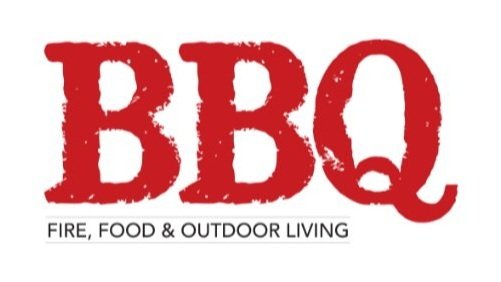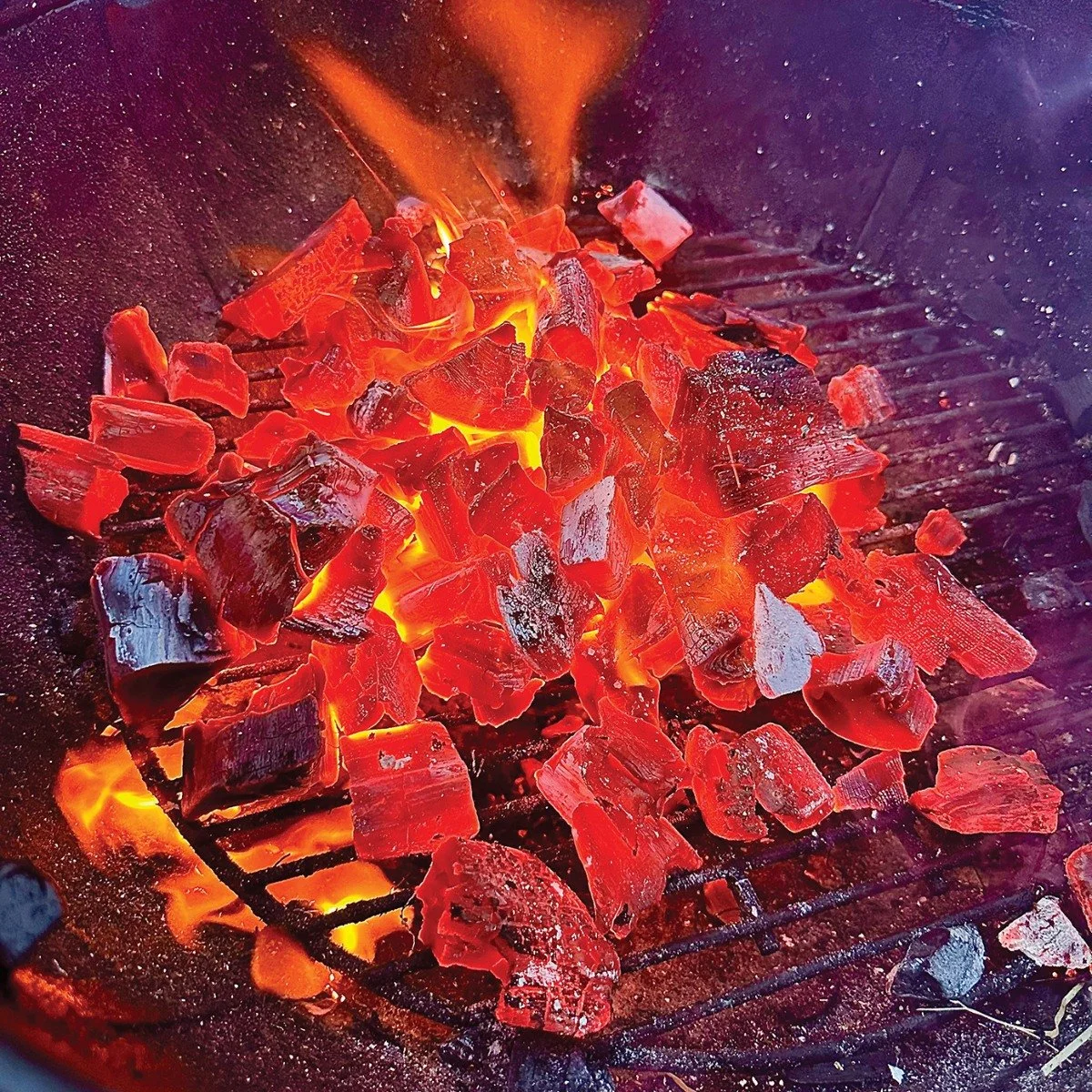Fuels out for summer
Old king coal is the soul of many a barbecue. JAMES BRACE heads for the woods near his Sussex home, laden with bags of charcoal to cook over
For as long as I can remember, I’ve been hypnotised by fire. From helping my nan light the open fire on Christmas morning with kindling and coal, to being transfixed by the flames in the fireplace of my grandpa’s cottage.
So it was no surprise that, as I grew up, I’d be drawn to cooking over fire and the love of a barbecue.
The sizzle of meat hitting the grill, the tantalising aroma wafting through the air, and the mouth-watering flavours that result from the cooking process, all add to the allure of this culinary experience – that’s part of the magic.
There is nothing more enriching and wholesome than lighting a fire, running some meat and vegetables through it and sharing laughs and food with family and friends. If my guests leave with full bellies, then my heart is full.
Recently, we have seen the explosion in interest in outdoor cooking in the UK, with an array of great grills complemented by great fuel.
Charcoal is a culinary trigger for me. It means fire food is coming, both a romantic and primal awakening.
Fuel is a vital ingredient for any BBQ, and I mean ingredient. When it comes to cooking, I will buy and source the best meat or vegetables I can afford, and this applies to the charcoal too.
What is charcoal? When we go to pick up a bag, do we really know what we’re buying or looking for?
Charcoal is defined as: ‘a black, lightweight, and porous form of carbon created through a process called pyrolysis. It is produced by heating organic material, such as wood or coconut shells, in the absence of oxygen. This lack of oxygen prevents the material from burning completely, resulting in the formation of charcoal.’
Yet, as with most things, not all charcoal is created equal. Time to fire up the Weber Master-Touch 57, with and without the charcoal baskets, and test some of the coals on the market.
First up, Birchwood Forestry, a fourth-generation family business in Herefordshire, sourcing raw timber from local woodlands and supplying independent farm shops and butchers with its sustainable lumpwood charcoal.
I cooked some venison over a batch of the oak charcoal, with excellent heat retention and a clean burn. I also used some of the apple charcoal in combination with wild cherry wood chunks, ideal for a smoked pork shoulder.
When tending a fire, don’t fiddle and adjust unnecessarily, randomly poking with a stick and invariably destroying the structure you’ve built. A lot of energy gets wasted that way. This is especially true with charcoal. If you get the zones and bed right from the start, the rest falls into place. Let the fuel do its thing.
Next in the grill was Globaltic and its lumpwood charcoal from Ukrainian silver birch trees, using just the core, ensuring large chunks for long burn times. The coals lit well, creating a nice bed to cook on, with even heat distribution, making multizone cooking easy to manage.
Time to try lumpwood charcoal from a kamado grill manufacturer. Big Green Egg states that each of its three pure lumpwood charcoals ‘will enhance your cook in a different way’. It also advocates ‘dirty cooking’ directly on the coals, such is the confidence in its purity and quality.
It’s a versatile charcoal and, says Big Green Egg, brings well-rounded smokiness to a brisket, a roast chicken, or a whole side of salmon.
I selected the oak and hickory flavour, having only used hickory before in my offset cooks. I went for a tri-tip of beef – good flavour and great heat release throughout, managed by controlling the airflow, with the coal responding well.
I had also taken delivery of a big bag of ACH15 restaurant grade lumpwood and a box of Binchotan charcoal from Big K, burning well from the start and maintaining a great source of heat throughout.
Big K dates back nearly 60 years when founder Theodoros Kleanthous immigrated to the UK from Cyprus, setting up his own restaurant in London. He could not find the right charcoal for his authentic Greek cooking, so brought it in from Cyprus.
Binchotan charcoal is typically used in a Konro-style grill. I went with yakitori chicken skewers and also reverse seared some ribeye steaks on the Master-Touch, with the crust on the steaks from the intense sear to finish something to behold.
Kamado Joe’s Big Block charcoal is big in size and flavour. The bigger blocks of this XL lumpwood were destined for my Country Fire Kitchen stand where, even open to unlimited oxygen, they produced a sustained level of heat and had a great burn time.
Kamado Joe, purveyors of the iconic red ceramic grills, worked with ‘Argentinian charcoal masters’ to develop an exclusive blend of hardwoods. Such is the density they are known as axe breakers by the locals, with the natural lump charcoal burning long and clean.
Black Dog Forestry, from Wiston in West Sussex, was, says director Alistair Sowter, “born from a love of the great outdoors and sustainable woodland management.” You had me at black dog Alistair, especially if a puppy!
The Black Dog lumpwood charcoal, made in house, arrived in solid 3kg and 7.5kg bags with a lovely twine stitching. You instantly notice how clean the coals are – no smell, no residue, just carbon and ready to go. I actually used the bag as a firelighter and the coals were ready in under five minutes.
I grilled some sea bass and tenderstem broccoli, with the Black Dog coals tickling the fillets and vegetables with heat and flavour, perfect for the delicate ingredients.
I then went for some steak for extra protein, and potatoes for home fries the next day, making use of some of the residual heat.
Let’s end with Weber, my first love and my first grill and a brand I still use today and at least three times a week.
I was sent Weber’s regular briquettes, as well as coconut shell ones. The briquettes lend themselves to the longer cooks due to their uniform size and shape, ensuring a more guaranteed burn time and heat outlay.
I used a classic snake method of arranging the briquettes part of the way round my kettle and lit one end with two chunks of smoking wood at the beginning of the snake.
The coconut shell variety contains no wood, just carbonised coconut shells and tapioca starch. The briquettes were a solid performer on this longer cook, which helps to minimise the variables when fire cooking.
It is important to pay as much attention to your fuel as you do to your food selection when prepping for a barbecue.
A well-managed fire doesn’t need loads of fuel, so go easy with the initial pour; you can always shut down your grill by closing the vents and with quality charcoal you can save it for the next cook.
Finally, remember a product from a well-managed woodland made well not only gives you the best result, but also pays dividends for the world around you.
Talking of wood, that’s a whole other fuel for your fire, which we’ll light next time.
James Brace is an avid fire food enthusiast, happiest lighting up some coals and wood to feed family and friends. He favours wild game and US style smoked meats, as owner and head pitmaster at Jimmy’s Smoke House.
















